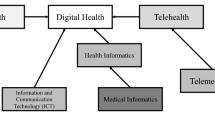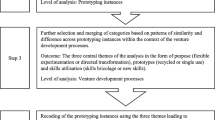Abstract
Although the scholarly conversation about how entrepreneurial opportunities emerge has suggested that entrepreneurs both discover and create opportunity components, specific knowledge about what components are discovered is lacking. In this research, we use an exploratory case study to investigate the opportunity creation process. We found that entrepreneurs discover several opportunity-related components based on the prior experience and knowledge of other entrepreneurs. Drawing on the evidence from these exploratory cases, we identify three important types of components that entrepreneurs creatively recombine within an emerging opportunity: technology stack, business model, and product and service design architecture. These findings have important implications for our understanding of entrepreneurial bricolage and entrepreneurial recycling, and their connection to the process of opportunity creation.
Similar content being viewed by others
Notes
The protocols used for the collection are available from the authors upon request.
References
Aggestam, M. (2014). Conceptualizing entrepreneurial capital in the context of institutional change. International Entrepreneurship and Managament Journal, 10, 165–186.
Alvarez, S., & Barney, J. (2007). Discovery and creation: alternative theories of entrepreneurial action. Strategic Entrepreneurship Journal, 1(1–2), 11–26.
Anderson, C. (2008). Free! Why $0.00 is the future of business. Wired.
Ardichvili, A., Cardozo, R., & Ray, S. (2003). A theory of entrepreneurial opportunity identification and development. Journal of Business Venturing, 18(1), 105–123.
Arminio, J. L., & Hultgren, F. H. (2002). Breaking out from the shadow: the question of criteria in qualitative research. Journal of College Student Development, 43(4), 446–460.
Baguley, R. (2013). The gadget we miss: the Nokia 9000 communicator. People & Gadgets.
Baker, T., & Nelson, R. E. (2005). Creating something from nothing: resource construction through entreprenurial bricolage. Administrative Science Quarterly, 50, 329–366.
Baron, R. A. (2004). The cognitive perspective: a valuable tool for answering entrepreneurship’s basic “why” questions. Journal of Business Venturing, 19(2), 221–239.
BBC. (2005). How Skype and Kazaa changed the net BBC News.
Břllingtoft, A., & Ulhři, J. P. (2005). The networked business incubator: leveraging entrepreneurial agency? Journal of Business Venturing, 20(2), 265–290.
Bygrave, W. D. (2006). The entrepreneurship paradigm (I) reviisited. In H. Neergaard & J. Parm Ulhoi (Eds.), Handbook Of qualitative research methods in entrepreneurship (pp. 17–45). Cheltenham: Edward Elgar.
Cassar, G., & Craig, J. (2009). An investigation of hindsight bias in nascent venture activity. Journal of Business Venturing, 24, 149–164.
Chamberlain, G. P. (2006). Researching strategy formation process: an abductive mehodology. Quality and Quantity, 40, 289–301.
Charny, B. (2003a). Is VoIP ready for the prime time? cnet News.
Charny, B. (2003b). Why VoIP is music to Kazaa's ear. Cnet News.
Cloud, J. (2006). The gurus of YouTube: how a couple of regular guys built a company that changed the way we see ourselves. Time Magazine U.S.
CNN. (2006). CNN News on YouTube.
Davidsson, P. (2012). Entrepreneurial opportunity and the entrepreneurship nexus: a reconceptualization. In The Academy of Management Annual Meeting: the Informal Economy.
Desa, G., & Basu, S. (2011). Overcoming resource constraints in global social entrepreneurship. Strategic Entrepreneurship Journal, 7(1), 26–49.
Dimov, D. (2007). Beyond the single-person, single-insight attribution in understanding entrepreneurial opportunities. Entrepreneurship: Theory and Practice, 31(5), 713–731.
Dimov, D. (2011). Grappling with the unberable elusiveness of entreprenurial opportunites. Entrepreneurship: Theory and Practice, 35(1), 57–81.
Dutta, D. K., & Crossan, M. M. (2005). The nature of entrepreneurial opportunities: understanding the process using the 4I organizational learning framework. Entrepreneurship: Theory and Practice, 29(4), 425–449.
Ebben, J., & Johnson, J. (2006). Bootstrapping in small firms: an empirical analysis of change over time. Journal of Business Venturing, 21, 851–865.
Fiet, J. (1996). The informational basis of entreprenurial discovery. Small Business Economics, 8(6), 419–430.
Flyvbjerg, B. (2006). Five misunderstandings about case-study research. Qualitative Inquiry, 12(2), 219–245.
Fuentes Fuentes, M., Arroyo, M. R., Bojica, A. M., & Perez, V. F. (2010). Prior knowledge and social networks in the exploitation of entrepreneurial opportunities. International Entrepreneurship and Managament Journal, 6, 481–501.
Gannes, L. (2010). Case studies in Freemium: Pandora, Dropbox, Evernote. Gigaom: Automattic and MailChimp.
Gibbert, M., Ruigrok, W., & Wicki, B. (2008). What passes as a rigorous case study? Strategic Management Journal, 29, 1465–1474.
Gilson, D. (2012). The history of Symbian’s secret fragmentation. All About Symbian, globalchange.com (2007). YouTube co-founder Chad Hurley interview. globalchange.com.
globalchange.com. (2007). YouTube co-founder Chad Hurley interview. globalchange.com.
Grush, A. (2012). IBM Simon: world’s first smartphone is now 20 years old. Android Authority.
Heckman, J. J. (1979). Sample selection bias as a specification error. Econometrica, 47(1), 153–161.
Hindle, K. (2004). Choosing qualitative methods for entrepreneurial cognition research: a canonical development approach. Entrepreneurship: Theory and Practice, 28(6), 575–607.
Huldschiner, H. (2008). Filantropen Niklas Zennström och Skype med mera.
Hurley, C., Chen, S., & Anderson, C. (2007). YouTube Founders Chad Hurley & Steve Chen.
Karim, J. (2006). YouTube: from concept to hypergrowth.
Krueger, N. J. (2000). The cognitive infrastructure of opportunity emergence. Entrepreneurship: Theory and Practice, 25(3), 5–25.
Lasica, J.D. (2004). The Engadget interview: Niklas Zennström. Engadget,
Leitch, C. M., Hill, F. M., & Harrison, R. T. (2010). The philosophy and practice of interpretivist research in entrepreneurship. Organizational Research Methods, 13(1), 67–84. doi:10.1177/1094428109339839.
Levi-Strauss, C. (1967). The savage mind. Chicago: University of Chicago Press.
Maney, K. (2006). Distrupter man goes after TV this time. USA Today.
Mason, C. M., & Harrison, R. T. (2006). After the exit: acquisitions, entrepreneurial recycling and regional economic development. Regional Studies, 40(1), 55–73.
Murphy, G. B., Trailer, J., & Hill, R. (1996). Measuring performance in entrepreneurship research. Journal of Business Research, 36(1), 15–23.
Neergaard, H., & Ulhři, J. P. (2006). Introduction: Methodological variety in entrepreneurship research. In Handbook of qualitative research methods in entrepreneurship (pp. 1–13). Cheltenham: Edward Elgar.
Nelson, R. R. (2008). Bounded rationality, cognitive maps, and trial and error learning. Journal of Economic Behaviour and Organization, 67(1), 78–89.
Nicolaou, N., & Shane, S. (2009). Can genetic factors influence the likelihood of engaging in entrepreneurial activity? Journal of Business Venturing.
O’Reilly. (2005). What Is Web 2.0: Design patterns and business models for the next generation of software.
Plesser, A. (2007). YouTube Co-Founder Steve Chen: “It’s Going to Take a Little More Time” for Ad Monetization.
Raffi, D., & Rüling, C. (2010). Towards a foudation of bricolage in organization and management theory. Organization Studies, 31(2), 133–151.
Read, S., Song, M., & Smith, W. (2009). A meta-analytic review of effectuation and venture performance. Journal of Business Venturing, 24(6), 573–587.
Ritchie, R. (2013). History of iPhone (Original): apple reinvents the phone. imore.com.
Roese, N. J., & Olson, J. M. (1996). Counterfactuals, causal attributions, and the hindsight bias: a conceptual integration. Journal of Experimental Social Psychology, 32, 197–227.
Ruef, M., Aldrich, H., & Carter, N. (2003). The structure of founding teams: Homophily, strong ties and isolation among U.S. entrepreneurs. American Sociological Review, 68(2), 195–222.
Sarason, Y., Dean, T., & Dillard, J. F. (2006). Entrepreneurship as the nexus of individual and opportunity: a structuration view. Journal of Business Venturing, 21(3), 286–305.
Sarasvathy, S. (2001a). Causation and effectuation: toward a theoretical shift from economic inevitability to entrepreneurial contingency. Academy of Management Review, 26, 243–263.
Sarasvathy, S. (2001). Effectual reasoning in entreprenurial decision making: existence and bounds. In Academy of Management Proceedings 2001, 2001b
Sarasvathy, S. (2004). Making it happen: beyond theories of the firm to theories of firm design. Entrepreneurship: Theory and Practice, 28(6), 519–531.
Schumpeter, J. A. (1950). Capitalism, socialism and democracy (Vol. 3). New York: Harper-Collins.
Shane, S. (2012). Reflections on the 2010 AMR decade award: delivering on the promise of entreprenurship as a filed of research. Academy of Management Review, 37(1), 10–20.
Shane, S., & Venkataraman, S. (2000). The promise of entrepreneurship as a field of research. Academy of Management Review, 25(1), 217–226.
Suddaby, R., Burton, G. D., & Si, X. S. (2015). Entrepreneurship through a qualitative lens: insights on the construction and/or discovery of entrepreneurial opportunity. Journal of Business Venturing, 30, 1–10.
Teece, D. J. (2010). Business model, buiness strategy and inovation. Long Range Planning, 43, 172–194.
The Meaning of Free Speech. (2005). The Economist.
Thompson, C. (2005). The BitTorrent effect. WIRED, 13(1).
Trimi, S., & Bebegal-Mirabent, J. (2012). Business model innovation in entrepreneurship. International Entrepreneurship and Managament Journal, 8, 449–465.
Ucbasaran, D., Westhead, P., & Wright, M. (2009). The extent and nature of opportunity identification by experienced entrepreneurs. Journal of Business Venturing, 24(2), 99–115.
Vaghely, I. P., & Julien, P.-A. (2010). Are opportunities recognized or constructed? An information perspective on entrepreneurial opportunity identification. Journal of Business Venturing, 25(1), 73–86.
Venkataraman, S., Sarasvathy, S. D., Dew, N., & Forster, W. R. (2012). Reflections on the 2010 AMR decade award: whither the promise? Moving forward with entrepreneurship as a science of the artificial. Academy of Management Review, 37(1), 21–33.
Yin, R. K. (2003). Case study research: Design and methods (Applied Social Research Methods Series). London: Sage Publications.
YouTube. (2007). Interview with Steve Chen, Founder of YouTube.
Author information
Authors and Affiliations
Corresponding author
Rights and permissions
About this article
Cite this article
Stritar, R., Drnovšek, M. What entrepreneurs discover when creating opportunities? Insights from Skype and YouTube ventures. Int Entrep Manag J 12, 659–679 (2016). https://doi.org/10.1007/s11365-015-0362-7
Published:
Issue Date:
DOI: https://doi.org/10.1007/s11365-015-0362-7




